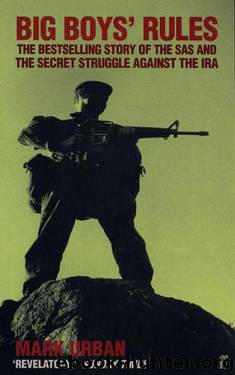Big Boys' Rules: The SAS and the Secret Struggle Against the IRA by Mark Urban

Author:Mark Urban [Urban, Mark]
Language: eng
Format: epub
Tags: History, Military, Special Forces, World War I, Biography & Autobiography, General
ISBN: 9780571266685
Google: Rxv-AjvWsCQC
Publisher: Faber & Faber
Published: 2012-12-20T00:00:00+00:00
14
Hunger Strikers and Supergrasses
The development of the protest at the Maze prison, following the abolition in 1976 of special category status for prisoners of terrorist groups, prompted the IRA to switch more of its resources from the armed struggle into the political work of Sinn Fein. Since the change in policy from treating imprisoned paramilitaries effectively as PoWs – allowing them to wear their own uniforms, for example – to dealing with them as ordinary criminals, the jail had become the focus for a battle of wills between the inmates and their guardians.
The prisoners’ first act of defiance was to refuse to wear regulation clothing, wrapping themselves in blankets instead. Prisoners’ claims that they were being beaten by officers when they went for showers ended up with them refusing to leave their cells. In April 1978 the ‘dirty protest’ began, with hundreds of republicans choosing to campaign for the return of political status and privileges by staying in their cells and covering the walls with their own excreta. The authorities did attempt occasional cleaning of the cells but did not have the resources to do so regularly. Perhaps also they underestimated the impact on public opinion which photos smuggled out of the prison would generate.
Although the Maze had been designed as one of Europe’s most modern prisons – less crowded and more comfortable than jails in Britain – conditions in the cells of prisoners on the dirty protest soon deteriorated. Maggots appeared, infesting the excreta and uneaten food. The willingness of the prisoners to subject themselves to confinement in these conditions soon caught the attention of the media and triggered an emotional upsurge in the nationalist community. The authorities’ attempts to ameliorate the situation only highlighted their impotence. Cells were washed down with high pressure hoses and disinfectant, but within days would return to their putrid squalor as inmates continued their protest.
The prisoners’ plight attracted media interest around the world, putting the British government on the defensive. The protest had successfully switched attention from the reason the men were in jail to questions about the sort of government that could allow them to exist in such conditions. The media campaign was spearheaded by Sinn Fein’s publicity director, Danny Morrison. A veteran activist, Morrison developed an acute ability to recognize what journalists coming to Ulster wanted, and to mobilize the resources required to provide it quickly while ensuring that the republican message was not forgotten.
Gerry Adams, the former Belfast Brigade commander and one of the architects of the new IRA, had in 1979 become its overall leader, replacing Martin McGuinness as the Chief of Staff of the IRA Army Council, the Special Branch believed. Nobody was more aware of the need for political mobilization if the Provisionals were to sustain their support to fight the ‘long war’. Increasingly Adams saw the value of using Sinn Fein, republicanism’s shop front, to achieve this goal. Advice centres were opened in nationalist heartlands, giving help which ranged from telling people what benefits they could claim to showing them how to find out if a son or daughter had been taken to Castlereagh.
Download
This site does not store any files on its server. We only index and link to content provided by other sites. Please contact the content providers to delete copyright contents if any and email us, we'll remove relevant links or contents immediately.
Big Boys' Rules: The SAS and the Secret Struggle Against the IRA by Mark Urban(410)
This Land Is Their Land by David J. Silverman(370)
Emancipation After Hegel by Todd McGowan;(310)
Human Rights Education by Bajaj Monisha; Flowers Nancy;(252)
Rethinking Political Judgement by Maša Mrovlje(251)
